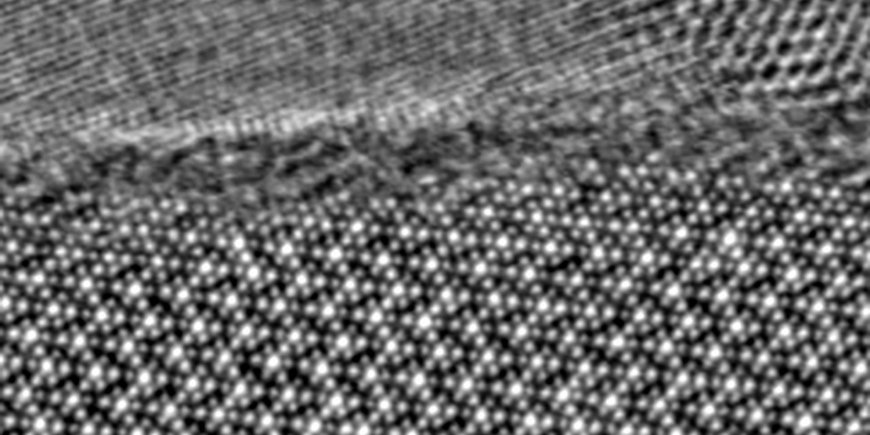Summary
The first measurements with the new transmission electron microscope (TEM) of the PISA (Potsdam Imaging and Spectral Analysis) Facility have shown the important contribution that such a state-of-the-art instrument can make to the geosciences. TEM expert Vladimir Roddatis from the GFZ Section 3.5 Interfacial Geochemistry is co-author of a study recently published in the journal Nature Astronomy. It investigates chemical weathering processes of a chondrite analogue mineral in ammonia-rich aqueous solutions in order to simulate conditions thought to exist on icy celestial bodies such as the mid-sized moons of Saturn and Uranus, or trans-Neptunian objects.
Until now, it has been unclear if such processes can take place on icy moons characterized by a mélange of frozen water and rock. New insights into this have now been provided by a team led by ISTerre (CNRS, Université Grenoble Alpes), with the participation of LEPMI (CNRS, Université Grenoble Alpes, Grenoble INP), LPG (CNRS, Nantes Université, Université d'Angers, Le Mans Université) and GFZ (Deutsches GeoForschungsZentrum Potsdam).
Chemical weathering also possible below the freezing point of water
Using long-term laboratory experiments on olivine crystals, the authors proved that continuous chemical weathering can also take place at temperatures less than 0 degrees Celsius. According to their study, the decisive factor is the presence of a thin film of liquid water enriched in anti-freeze compounds that surrounds the mineral grains that are enclosed in the ice matrix.
The researchers recreated the relevant conditions on icy celestial bodies in chemical reactors and thus studied the interaction of minerals with ice and ammonia-rich solutions at temperatures between -20 and +22°C, over a period of more than 440 days. For this purpose, they used olivine, a magnesium- and iron-containing silicate mineral, an essential component of many celestial bodies, including the Earth's crust and upper mantle, and measured how much magnesium and silicon was released from the olivine crystals into the surrounding liquid.
High-resolution TEM measurements provide crucial insights into dissolution processes at mineral surfaces on an atomic scale
"A decisive contribution to understanding the weathering processes at the surfaces of the olivine grains was made possible by using state-of-the-art analytical transmission electron microscopy methods at GFZ, which can image with atomic accuracy the structure and chemistry of minerals and their surroundings," says Roland Hellmann from ISTerre in Grenoble, and one of the lead authors of the study.
The measurements show that after more than a year of reaction at -20 °C, the olivine crystals developed a very thin amorphous, i.e. disordered, no longer crystalline, transition phase on their surface- proof of an aqueous alteration process. At the same time, liquid water, ammonia and carbonate ions were detected within the thin film at the crystal surfaces using Raman spectroscopy – corroborating the enrichment of anti-freeze compounds in the aqueous thin film, and thereby making olivine weathering at subfreezing temperatures possible.
TEM expert Vladimir Roddatis from the GFZ emphasises: "These results were only possible due to the new Thermo Fisher Scientific Themis Z Transmission Electron Microscope, which can image individual atoms due to its powerful resolution in the sub-Ångström range, and the associated extremely precise preparation of the samples by focused ion beam milling."
Roland Hellmann concludes: "The results are both surprising and of great impact, as many models of planetary chemical weathering assume that higher temperatures than those of ice melt (> 0°C) must be reached." Many other icy bodies in the outer solar system could also have liquid water and thus potentially favourable conditions for such weathering reactions, which are now shown to be a geologically rapid process.
About the instrument
The Themis Z Transmission Electron Microscope is part of the PISA–(Potsdam Imaging and Spectral Analysis) Facility hosted in Section 3.5 Interface Geochemistry. This microscope was funded by European Regional Development Fund and the State of Brandenburg funds. The PISA facility combines various state-of-the-art imaging and spectral analyses instruments and sample preparation facilities that are used for a large suite of geo, material and bio-research applications.
Original publication:
Zandanel, A., Hellmann, R., Truche, L. et al. Geologically rapid aqueous mineral alteration at subfreezing temperatures in icy worlds. Nat Astron (2022). DOI: 10.1038/s41550-022-01613-2
Scientific contact:
Dr. Vladimir Roddatis
Section 3.5 Interface Geochemistry
PISA Facility
Helmholtz Centre Potsdam
GFZ German Research Centre for Geosciences
Telegrafenberg
14473 Potsdam
Phone: +49 331 288-27567
Email: vladimir.roddatis@gfz-potsdam.de








![[Translate to English:] Torsten Sachs in front of a climate station on a field](/fileadmin/_processed_/3/9/csm__TorstenSachs_bearbeitet_GS_4a1365ef84.jpeg)

![[Translate to English:] left image flood at the Ahrtal: image from above, several houses are flooded; left image:: Heidi Kreibich;](/fileadmin/_processed_/4/4/csm_Bild2_9af0130e9f.png)



![[Translate to English:] Start der Vega Rakete](/fileadmin/_processed_/6/4/csm_20231201-kachel_Vega-VV23-launch_ESA-CNES-Arianespace_706716b68c.jpeg)









![[Translate to English:] Poster exhibition at the Brandenburg Hydrogen Day at the GFZ, some participants in the foreground](/fileadmin/_processed_/6/5/csm_Erster_Brandenburgischer_Wasserstofftag_GFZ_402fcec95e.jpeg)
![[Translate to English:] Group picture of the participants](/fileadmin/_processed_/9/4/csm_20231108_CAWa-Workshop-Tashkent_Gruppenbild_99ea779d8a.jpeg)

![[Translate to English:] [Translate to English:] Hörsaal](/fileadmin/_processed_/e/6/csm_H%C3%B6rsal_e21ac645fb.jpeg)


![[Translate to English:] The Delegations in the Historic Library on the Telegrafenberg. In the back there are from left to right, the Dutch Ambassador for Germany, Ronald van Roeden, the Dutch Minister for Education, Culture and Science, Robbert Dijkgraaf and the scientific director of the GFZ, Susanne Buiter.](/fileadmin/_processed_/d/b/csm_Kachel-2_9eba4b4212.jpeg)

